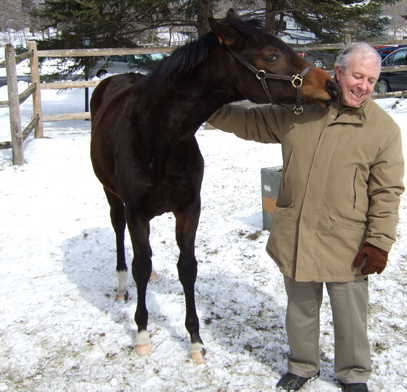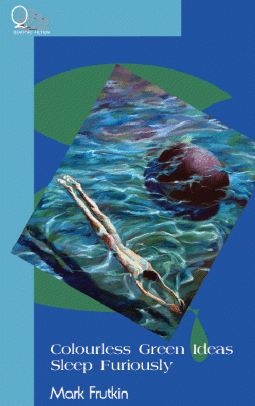 Author photo by Don Greenfield
Author photo by Don Greenfield
Herewith a collection of short essays (okay, call them aphorisms, extended aphorisms, epigrams, essays—delightful, meditative, exciting short thingies often constructed in balanced antitheses or with a Borgesian twist in the tail) by the award-winning novelist Mark Frutkin. These are from his forthcoming book Colourless Green Ideas Sleep Furiously: Short Essays and Alternative Versions (Quattro Books, Toronto, Spring 2012). Frutkin grew up in Cleveland before moving to Canada during the Vietnam War, settling there (he lives in Ottawa) and making his way as a writer. He is one of a brave band of American/Canadians of that era, many of whom had a profound influence on the development of a nascent Canadian literary brand in the 60s and 70s. For a lively recollection of his early years in the Great White North, read his 2008 memoir Erratic North, A Vietnam Draft Resister’s Life in the Canadian Bush (Dundurn).
His latest novel, Fabrizio’s Return (Knopf, 2006), won the Trillium and Sunburst Awards and was a finalist for the Commonwealth Writers’ Prize (Canada/Caribbean region). His most recent publication (September 2011) is a travel memoir, Walking Backwards: Grand Tours, Minor Visitations, Miraculous Journeys and a Few Good Meals. His 1988 novel, Atmospheres Apollinaire, was a finalist for the Governor General’s Award (fiction). Altogether he has published twelve books of fiction, poetry and non-fiction.
dg
.
From Colourless Green Ideas Sleep Furiously
Essays by Mark Frutkin
.
Fragments of a story
Story is what we use to conjure order out of chaos.
We charm chaos into narratives that replicate and reflect established perceptions of reality.
Though it appears to be nothing but fragments, the world is in fact a unified field: of cities, thoughts, food, language, dreams, bodies, hopes, fears and passions. The unifying factor is story, the ongoing whisper we hear in our heads, the tale we tell ourselves, no more real than any other story, a play we imagine, a dream we dream.
.
Letters ubiquitous
We glimpse letters everywhere: the H in the ladder and the fence, the S-bend in river and road, the alphabet on the telephone keypad, in the tangled garden, in the limbs of bodies walking the crowded street. The taps pour out letters in foaming chaos, so too do letters fly from the banner whipping in the wind. The Tibetans believe prayer flags, when fluttering in the breeze, release over and over the prayers printed on them. Cars and buses release sounds that represent alphabetic nonsense. Every mouth has a balloon attached, a bubble filled with words. Another balloon stretches and swells inside our heads. The three electric wires passing over my back yard are a lined page waiting to be filled in. The city is a kind of text, Borges’ infinite library broken free of restraint and gone mad, as if the letters and words have been liberated and come pouring out of the neo-classical building like inmates released from an asylum. The letters are a kind of god: ubiquitous and omnipresent. Like a primal foundational energy, they magnetize themselves, gather, cluster, resonate, creating an ongoing story of infinite complexity.
.
Questions and answers
Space is an attitude, a state of mind. Space the locus of creation, a void that is charged and potent. The creative begins with space. For the visual artist, space is the empty canvas. For the musician, space is silence. For the writer, space is the blank page – terrifying, voluptuous, irresistible.
We begin with an open mind. Beginning means refining and honing the question. If you come to a final and definitive conclusion – an answer – the space fills up with that conclusion and nothing more is possible.
The question that is asked is alarming and amazing because there is both danger and possibility. If there were no danger there would be no possibility.
But let us not forget about space – left-handed space filled with roaring dreams: if you try to describe space, it fills up with your words and is gone. Turning it over, it looks the same on the bottom as on top. It is always waiting and ready, charged and candescent.
.
Language as social consensus
Language is determined by social consensus. We agree that the sounds “win-dow” are the apertures in the house you can see through, and “pa-per” is what you hold in your hands when reading. The sounds, in and of themselves, mean nothing. We have agreed, society has agreed, that these sounds have meaning and we are inoculated with this code from birth, by hearing our parents, our siblings and our world speak. We are both nurtured and trapped in the nexus of meaning.
Our perceptions of reality as well are controlled by social consensus, and our ultimate limitations are defined by it. In subtle and profound ways that involve complete immersion in a cultural and linguistic atmosphere, we receive and pass on the codes and definitions of so-called reality. Artists stretch those limits, tyrants and madmen break them, everyone else ignores them by living inside them.
.
Sacred and profane
For the so-called primitive mind, the story is real. In fact, reality is a story, life is the enactment of a ritualized story. And in this ritual, everyday objects are sacred – no distinction is made between the sacred and the profane. The bowl, the grain in the bowl, the song sung while grinding the grain, the spoon and the overarching sun are all sacred because they are part of the story, embodiments of myth, both transcendent and mundane.
It is intriguing to consider what happened when primitive culture pervaded Western Europe early in the twentieth century, when cultural anthropologists such as Durkheim and Malinowski returned from exotic locales in Africa and New Guinea with their eyewitness reports. They wrote not only about the mating habits of the peoples there, but discussed their ‘primitive’ perceptions of reality, their views of the world.
This idea brought back from aboriginal cultures – that there was no distinction between the sacred and the profane – captivated the European artists and writers of the day. Suddenly the objects of traditional, classical poetry – the tombs, angels, fountains and flowers of the Victorians of England and many other European poets who preceded them – changed into the objects of the modern mundane world: the cigarettes, gas works and automobiles of Apollinaire and the Surrealists. The result was that Picasso felt free to paint Les Demoiselles d’Avignon using five Barcelona prostitutes as models and stuck a real piece of chair caning and a theatre ticket into a painting.
(Of course, Caravaggio, much maligned by the Victorians, was a precursor of this approach with one crucial difference: Caravaggio used courtesans as models for religious figures whereas Picasso used prostitutes as prostitutes.)
Somehow, the Western world flipped the primitive view around and said, all is profane and nothing is sacred, rather than realizing that the sacred and profane were one and the same. This state of mind helped foster the breakdown of traditional institutions for good and ill: monarchies were buried forever, institutional religion lost much of its power (the Jesuits were thrown out of France early in the twentieth century), and the family began a slow but profound evolution.
The horrors of the past century stand as a symbol for the West’s embracing of the polar opposite of what the so-called primitive peoples believed. The West came to believe this and this alone: Nothing is sacred. Two world wars, the holocaust and the atom and hydrogen bombs are testaments to this belief. How did we get from “no distinction between the sacred and the profane” to “nothing is sacred”?
Understanding how our view of reality is limited might help us imagine a realm where the sacred and profane come together. This is the possibility that enchanted some artists early in the twentieth century: the idea that the imagination could recreate the world. As in any shamanistic endeavour, there was danger. Little did they know that one imagination trying to recreate the world would be Hitler’s.
.
Troy Imagined
At the height of the Victorian era, the amateur German archaeologist Heinrich Schliemann found Troy VIIa, proving that the Trojan Wars were not fable but a part of history, that the shield of Odysseus rang in the brilliance of real light, and Hector’s legs hugged the back of a breathing horse.
Certain scholars today question these findings. The historical veracity of the Trojan Wars is again under suspicion. I do not wish to become embroiled in this scholarly argument, but I would like to explore what this might suggest.
What we have here, in the back and forth between the fact and fiction of Troy and the Homeric epic (some of our earliest literature), is, quite literally, the profound power of the imagination, its ability to breathe life into matter. For thousands of years a city of men and women peopled the human mind. For thousands of years, listeners heard the words of Homer, assembled the stone blocks of Troy in their imaginations, limned the face of Helen, struck the shields of a thousand warriors.
The tale had power. Its roots thrust ever deeper into the human fabric, into human soil. Each listener who heard or told the tale added to its depth, its profundity. One day a chiselled piece of half-buried stone appeared on the plains of northwestern Asia Minor, not far from the waves of the Thracian Sea breaking over and over on the shore like lines of text.
A portion of wall appeared out of the earth. This happened long before Schliemann arrived. A helmet with a skull inside glinted for a moment in the sun, then was covered by dust moved by near and distant winds.
And still people listened to the tale. Fathers told sons and daughters, older brothers told younger. People heard the tale repeat itself inside their own heads, listened to their own imaginations taking life.
Meanwhile, the city of ruins was assembling itself on the plains. Tarnished shields appeared and poked out of the earth. Shards of pots, layers of paving stones, the point of a spear, all appeared and sank again under generations of soil and dust. Troy was imagined into existence and prepared for Schliemann’s coming.
A trader passed nearby once and saw nothing, though he sensed a certain power in the region and fine words rose to the surface of his mind as he rode by.
—Mark Frutkin

This is brilliant stuff. Thank you so much for sharing these shimmering thoughts.
Yes, brilliant. I particularly like “Language as social consensus,” perhaps because the resonance with science is strong. In science we are continually asking ourselves, “what is it that we actually know?” Finding those places where our minds have filled in the gaps for the sake of narrative, where we don’t actually know, that is precisely the stuff of discover. Loved the rest of this excerpt too and am looking forward to the book. Thanks, dg and Mark Frutkin.
I love the collusions I’m invited to enter, especially in lines like this one: “left-handed space filled with roaring dreams.” I’m pulled in (not only because I’m left-handed) but because right-handed space is left wide open for me to fill with my own roaring dreams. Lovely. Thank you!